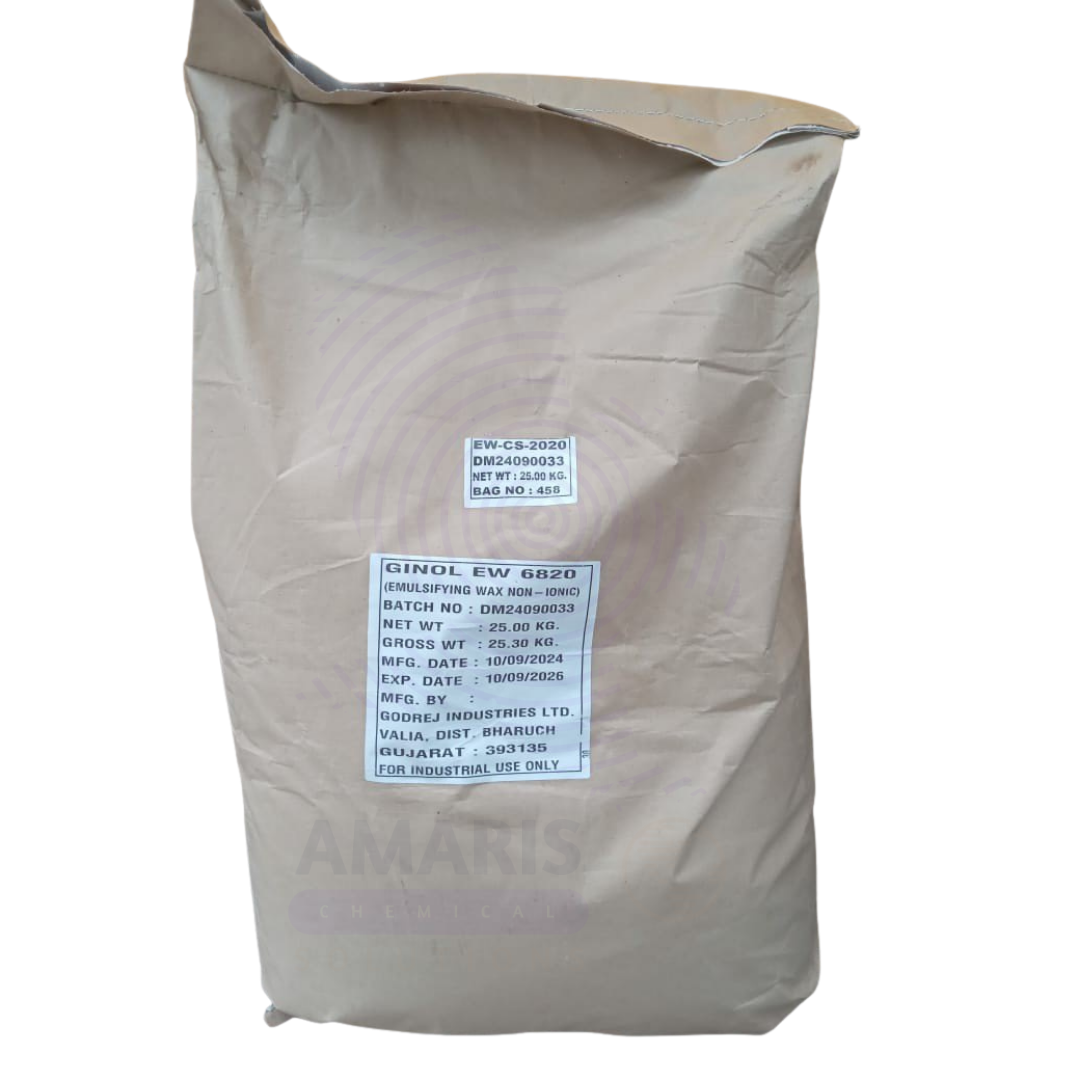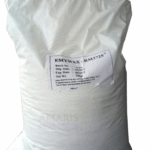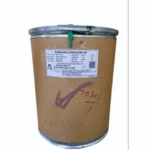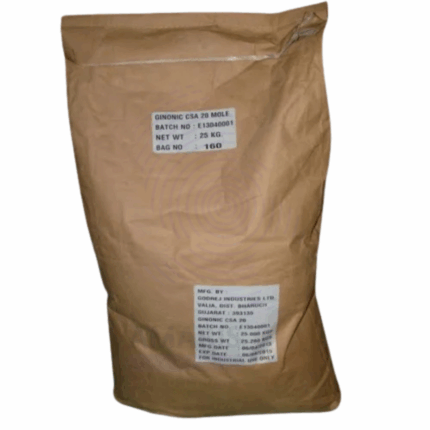Emulsifying Wax Non ionic
Whatsapp Order
Emulsifying Wax Non ionic is a self-emulsifying, non-ionic wax blend composed primarily of fatty alcohols (typically cetostearyl alcohol or stearyl alcohol) and non-ionic surfactants like polyethylene glycol (PEG) derivatives. It is used to stabilize oil-in-water (O/W) emulsions without relying on ionic charges, making it highly compatible with a wide range of ingredients, including both cationic and anionic components. This wax is commonly found in white, odorless solid flakes or pellets and is dispersible in hot water to form smooth, stable emulsions. It is widely used in cosmetic, pharmaceutical, and industrial applications where gentle emulsification, stability, and broad pH compatibility are needed.
Description
Table of Contents
Toggle
Emulsifying Wax Non ionic
Primary Uses
- Cosmetics & Personal Care
- Creams and Lotions: Primary emulsifier in facial moisturizers, body butters, and anti-aging products, offering stability and smooth texture.
- Hair Conditioners and Leave-in Treatments: Provides mild emulsification and a soft, silky finish without interfering with conditioning agents.
- Sunscreens and BB Creams: Emulsifies UV filters and other actives in oil-in-water systems, helping achieve uniform application.
- Eye Creams and Serums: Suitable for sensitive formulations due to its non-ionic, low-irritant profile.
- Baby Care Products: Preferred in formulations for infants and sensitive skin due to its non-reactive, non-irritant nature.
- Makeup Products: Used in foundations, primers, and cream-based cosmetics for consistent emulsification and product feel.
- Pharmaceuticals
- Topical Creams and Ointments: Used in medicated bases such as antifungal creams, corticosteroids, and antibiotic ointments to ensure emulsion stability.
- Transdermal Systems: Aids in even dispersion of APIs (active pharmaceutical ingredients) in creams and gels for better skin absorption.
- Dermatological Preparations: Helps stabilize emulsions for treatments targeting eczema, dermatitis, and psoriasis.
- Suppositories and Semi-solid Bases: Used in non-aqueous emulsions and pharmaceutical creams requiring non-ionic compatibility.
- Household & Industrial Products
- Fabric Conditioners: Used in emulsifying fragrances and softening agents without disrupting ionic surfactants.
- Polishes and Waxes: Stabilizes emulsions in wood, leather, or car care products, where ionic surfactants may interfere with other actives.
- Surface Cleaners: Mild emulsifier in premium household cleaning sprays, especially for surfaces sensitive to high alkalinity.
- Textile Auxiliaries: Helps disperse oils and softeners uniformly in non-ionic textile finishing agents.
Secondary Uses
- Food Industry (if food-grade variant)
- Cream Fillings and Icings: Acts as a stabilizer and emulsifier in food emulsions (only if food-grade certified).
- Nutraceutical Creams or Supplements: Used in topical or semi-solid delivery systems of vitamins or herbal extracts.
- Paints, Coatings & Adhesives
- Emulsion Polymerization: Stabilizes monomer droplets in water-based polymer synthesis.
- Adhesive Formulations: Maintains uniformity and texture in non-aqueous and aqueous adhesive blends.
- Agriculture
- Pesticide Formulations: Used as an emulsifier and dispersant in agrochemical sprays where ionic surfactants may destabilize active ingredients.
- Fertilizer Blends: Emulsifies oils and vitamins in foliar sprays and micronutrient solutions.
KEY PRODUCT FEATURES
1. Basic Identification Attributes
- Chemical Name (IUPAC): Blend of non-ionic polyoxyethylene ethers and fatty alcohols
- Common/Trade Name: Emulsifying Wax – Non-Anionic
- CAS Number: Mixture (common components include CAS 67762-27-0 and CAS 9005-00-9)
- HS Code: 3402.13.00
- Molecular Formula: Variable depending on PEG and alcohol chain length
- Synonyms:
- Non-Ionic Emulsifying Wax
- PEG-fatty alcohol condensates
- Self-Emulsifying Wax
- Emulsifying Wax NF
- Cetearyl Alcohol and PEG derivatives
2. Physical & Chemical Properties
- Physical State: White to off-white solid flakes or pellets
- Odor: Odorless or faintly waxy
- Melting Point: 50–55°C
- pH (1% dispersion): 6.0–8.0 (neutral to mildly alkaline)
- Solubility: Dispersible in hot water; soluble in alcohols and glycols
- Stability: Stable under normal conditions; compatible with wide pH range (4–9)
- Cloud Point: Typically above 70°C
- Emulsion Type: Primarily oil-in-water (O/W)
3. Safety & Hazard Attributes
- Hazard Class (GHS): Not classified as hazardous
- Toxicity: Low; generally recognized as safe for topical use
- Exposure Limits: Not established
- Flammability: Non-flammable; may burn under high heat
4. Storage & Handling Attributes
- Storage Conditions: Store in cool, dry, well-ventilated area away from direct heat and moisture
- Container Type: Fiber drums with PE liners or HDPE bags
- Shelf Life: 24 months under appropriate conditions
- Handling Precautions: Avoid moisture contamination and excessive heat during storage
5. Regulatory & Compliance Attributes
- FDA Status: Approved for use in topical drug and cosmetic formulations (not approved for ingestion unless food-grade variant)
- USP/NF Grade: Available for pharmaceutical use
- REACH Registered: Yes
- RoHS/TSCA Status: Compliant in many regions
6. Environmental & Health Impact
- Biodegradability: Readily biodegradable
- Ecotoxicity: Low; safe for use in rinse-off products
- Bioaccumulation: Not expected
- Carcinogenicity/Mutagenicity: Not classified as carcinogenic or mutagenic
SAFETY HANDLING PRECAUTIONS
Safety Handling Precautions
PPE Required:
- Chemical-resistant gloves
- Safety goggles
- Protective apron or lab coat
- Dust mask or respirator if powder is airborne
Handling Guidelines:
- Use in a clean, ventilated workspace
- Avoid generating dust during transfer or mixing
- Add slowly into hot water under agitation to prevent clumping
- Avoid contact with eyes or prolonged skin exposure
Storage Measures:
- Keep containers tightly sealed when not in use
- Store away from oxidizing agents and moisture
- Protect from freezing or excessive heat
- Use dedicated, labeled storage containers
Hygiene Practices:
- Wash hands thoroughly after handling
- Do not eat, drink, or smoke during use
- Clean utensils and surfaces after processing
- Avoid contamination with other chemicals
First Aid Measures
- Inhalation: Move to fresh air; seek medical attention if symptoms occur
- Skin Contact: Wash with soap and water; consult physician if irritation develops
- Eye Contact: Flush eyes with water for at least 15 minutes; seek medical help if irritation persists
- Ingestion: Rinse mouth with water; not expected to be harmful in small quantities, but seek medical advice
Firefighting Measures
- Fire Hazards: Slightly combustible at high temperatures
- Extinguishing Media: Dry chemical, foam, carbon dioxide (CO₂), or water mist
- Special Precautions: Use self-contained breathing apparatus and protective gear in case of large fire
- Decomposition Products: May release carbon monoxide, carbon dioxide, and mild organic vapors
Related products
Cetomacrogel 1000BP
Cetomacrogel 1000BP is a high molecular weight polyethylene glycol (PEG) derivative, typically used as a thickening agent, emulsifier, and stabilizer in pharmaceutical and cosmetic formulations. It appears as a white to off-white, waxy solid or flakes with a neutral odor. Known for its excellent water solubility and compatibility with various ingredients, Cetomacrogel 1000BP enhances texture, viscosity, and stability in creams, ointments, and gels. It serves as a hydrophilic vehicle base in topical and oral pharmaceutical preparations and improves product spreadability and skin feel.
Cetomacrogol PEG1000 (Ginonic CSA 20)
Cetomacrogol PEG (Ginonic CSA) is a polyethylene glycol-based nonionic surfactant and emulsifier with an average molecular weight of approximately 1000 Da. It appears as a white to off-white waxy solid or flakes with a neutral odor. This high-quality grade is widely used in cosmetic, pharmaceutical, and personal care formulations due to its excellent emulsifying, solubilizing, and moisturizing properties. Cetomacrogol PEG1000 (Ginonic CSA 20) facilitates stable oil-in-water emulsions, improves product texture and skin feel, and enhances the bioavailability of active ingredients. Its hydrophilic nature and compatibility with a wide range of ingredients make it a versatile additive in creams, lotions, ointments, and topical gels.
Cetyl Trimethyl Ammonium Chloride
Cetyl Trimethyl Ammonium Chloride (CTAC) is a cationic surfactant and quaternary ammonium compound characterized by a long hydrophobic cetyl (C16) alkyl chain and a positively charged ammonium head group. It appears as a white to pale yellow powder or flakes, soluble in water, and exhibits strong surface-active properties. CTAC is widely used in cosmetics, personal care, and industrial applications for its excellent conditioning, antistatic, emulsifying, and disinfectant capabilities. It functions primarily as a fabric softener, hair conditioner, and antimicrobial agent.
Galaxy CAPB
Galaxy CAPB is a high-performance amphoteric surfactant based on Cocamidopropyl Betaine, produced from coconut fatty acids. It appears as a translucent to pale yellow liquid with mild viscosity and a mild coconut-like odor. As a zwitterionic surfactant, it provides exceptional foaming, mildness, and synergistic compatibility with other surfactants, making it ideal for personal care, household, and industrial formulations.
Galsilk 700
Galsilk (Polyquartenum) is a water-soluble cationic polymer known chemically as Polyquaternium-7. It is widely used as a conditioning agent in personal care and cosmetic formulations, prized for its excellent substantivity to hair and skin, providing softness, smoothness, and antistatic effects. This polymer is typically supplied as a clear to slightly hazy viscous liquid or gel. It is compatible with a broad range of surfactants and ingredients, enhancing the sensory profile of shampoos, conditioners, styling products, and skincare formulations. Galsilk 700 is also valued for its film-forming properties and ability to improve product stability.
Polyglyceryl
Polyglyceryl refers to a family of non-ionic surfactants and emulsifiers made by the polymerization of glycerol units. Depending on the number of glycerol units (e.g., Polyglyceryl-2, -3, -6, -10) and fatty acid esterification (e.g., laurate, oleate, stearate), they offer different emulsifying and solubilizing properties. These compounds are biodegradable, mild, and skin-friendly, making them ideal for use in cosmetics, food, pharmaceuticals, and personal care products. Polyglyceryl esters are often chosen in natural and organic product formulations due to their origin and non-toxic profile.
Polysorbates
Polysorbates are a class of nonionic surfactants derived from sorbitol and fatty acids, commonly used as emulsifiers, solubilizers, and dispersing agents in a wide range of industries. They improve the mixing of oil and water phases, stabilize emulsions, and enhance the texture and consistency of formulations. Polysorbates are widely used in pharmaceuticals, cosmetics, food products, and industrial applications due to their biocompatibility, low toxicity, and effectiveness at low concentrations.
Stearyl Alcohol
Stearyl Alcohol 98% is a high-purity, long-chain fatty alcohol derived from natural fats and oils. It is widely used across various industries due to its emulsifying, thickening, and lubricating properties. In industrial and cosmetic formulations, it functions as a non-ionic surfactant, emollient, and viscosity modifier. The 98% purity ensures consistent performance in applications requiring high-grade material.


 Preservatives(food)
Preservatives(food) Flavor Enhancers
Flavor Enhancers Acidulants
Acidulants Sweeteners
Sweeteners Antioxidants
Antioxidants Colorants(food)
Colorants(food) Nutraceutical Ingredients (food)
Nutraceutical Ingredients (food) Nutrient Supplements
Nutrient Supplements Emulsifiers
Emulsifiers
 Collectors
Collectors Dust Suppressants
Dust Suppressants Explosives and Blasting Agents
Explosives and Blasting Agents Flocculants and Coagulants
Flocculants and Coagulants Frothers
Frothers Leaching Agents
Leaching Agents pH Modifiers
pH Modifiers Precious Metal Extraction Agents
Precious Metal Extraction Agents
 Antioxidants(plastic)
Antioxidants(plastic) Colorants (Pigments, Dyes)
Colorants (Pigments, Dyes) Fillers and Reinforcements
Fillers and Reinforcements Flame Retardants
Flame Retardants Monomers
Monomers Plasticizers
Plasticizers Polymerization Initiators
Polymerization Initiators Stabilizers (UV, Heat)
Stabilizers (UV, Heat)
 Antifoaming Agents
Antifoaming Agents Chelating Agents
Chelating Agents Coagulants and Flocculants
Coagulants and Flocculants Corrosion Inhibitors
Corrosion Inhibitors Disinfectants and Biocides
Disinfectants and Biocides Oxidizing Agents
Oxidizing Agents pH Adjusters
pH Adjusters Scale Inhibitors( water)
Scale Inhibitors( water)
 Antioxidants(cosmetic)
Antioxidants(cosmetic) Emollients
Emollients Fragrances and Essential Oils
Fragrances and Essential Oils Humectants
Humectants Preservatives
Preservatives Surfactants(cosmetic)
Surfactants(cosmetic) Thickeners
Thickeners UV Filters
UV Filters
 Fertilizers
Fertilizers Soil Conditioners
Soil Conditioners Plant Growth Regulators
Plant Growth Regulators Animal Feed Additives
Animal Feed Additives Biostimulants
Biostimulants Pesticides (Herbicides, Insecticides, Fungicides)
Pesticides (Herbicides, Insecticides, Fungicides)
 Active Pharmaceutical Ingredients (APIs)
Active Pharmaceutical Ingredients (APIs) Excipients
Excipients Solvents(pharmaceutical)
Solvents(pharmaceutical) Antibiotics
Antibiotics Antiseptics and Disinfectants
Antiseptics and Disinfectants Vaccine Adjuvants
Vaccine Adjuvants Nutraceutical Ingredients (pharmaceutical)
Nutraceutical Ingredients (pharmaceutical) Analgesics & Antipyretics
Analgesics & Antipyretics
 Analytical Reagents
Analytical Reagents Solvents(lab)
Solvents(lab) Chromatography Chemicals
Chromatography Chemicals Spectroscopy Reagents
Spectroscopy Reagents microbiology-and-cell-culture-reagents
microbiology-and-cell-culture-reagents Molecular Biology Reagents
Molecular Biology Reagents Biochemical Reagents
Biochemical Reagents Inorganic and Organic Standards
Inorganic and Organic Standards Laboratory Safety Chemicals
Laboratory Safety Chemicals Specialty Laboratory Chemicals(Special Laboratory Equipment)
Specialty Laboratory Chemicals(Special Laboratory Equipment)
 Demulsifiers
Demulsifiers Hydraulic Fracturing Fluids
Hydraulic Fracturing Fluids Scale Inhibitors(oil)
Scale Inhibitors(oil) Surfactants(oil)
Surfactants(oil) Drilling Fluids
Drilling Fluids
 Dyes and Pigments
Dyes and Pigments Bleaching Agents
Bleaching Agents Softening Agents
Softening Agents Finishing Agents
Finishing Agents Antistatic Agents
Antistatic Agents
 Admixtures
Admixtures Waterproofing Agents
Waterproofing Agents Sealants and Adhesives
Sealants and Adhesives Curing Compounds
Curing Compounds Concrete Repair Chemicals
Concrete Repair Chemicals Anti-Corrosion Coatings
Anti-Corrosion Coatings
 Surfactants(cleaning)
Surfactants(cleaning) Builders
Builders Enzymes
Enzymes Solvents (Cleaning)
Solvents (Cleaning) Fragrances
Fragrances
 Electronic Chemicals
Electronic Chemicals Catalysts
Catalysts Lubricants
Lubricants Photographic Chemicals
Photographic Chemicals Refrigerants
Refrigerants Automotive chemicals
Automotive chemicals Pyrotechnic Chemicals
Pyrotechnic Chemicals
 Biodegradable Surfactants
Biodegradable Surfactants Bio-based Solvents
Bio-based Solvents Renewable Polymers
Renewable Polymers Carbon Capture Chemicals
Carbon Capture Chemicals Wastewater Treatment Chemicals
Wastewater Treatment Chemicals
 Pigments
Pigments Solvents(paint)
Solvents(paint) Specialty Coatings
Specialty Coatings Binders/Resins
Binders/Resins Additives
Additives Driers
Driers Anti-Corrosion Agents
Anti-Corrosion Agents Functional Coatings
Functional Coatings Application-Specific Coatings
Application-Specific Coatings
 Fresh Herbs
Fresh Herbs Ground Spices
Ground Spices Whole Spices
Whole Spices Spice Blends
Spice Blends Dried Herbs
Dried Herbs
 Leavening Agents
Leavening Agents Dough Conditioners
Dough Conditioners Flour Treatments
Flour Treatments Fat Replacers
Fat Replacers Decoratives
Decoratives Preservatives(baking)
Preservatives(baking)
 Plasticizers & Softeners
Plasticizers & Softeners Reinforcing Agents
Reinforcing Agents Adhesion Promoters
Adhesion Promoters Vulcanizing Agents
Vulcanizing Agents Antidegradants
Antidegradants Blowing Agents
Blowing Agents Fillers & Extenders
Fillers & Extenders Accelerators & Retarders
Accelerators & Retarders




















